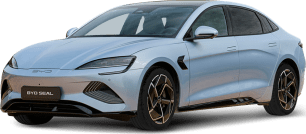The Seal has a huge cabin, and in a lot of ways it feels like the large sedans of old. You can sit nice and low in the cabin, and there’s heaps of knee and headroom thanks to its width.
Soft-clad materials for resting your knees and elbows on go a long way towards keeping this car comfortable on longer journeys, and the presence of a digital dash and a holographic head-up display is nice to have compared to the bare-bones dash of the Tesla Model 3.
The wacky rotating central touchscreen feature makes an appearance from other BYDs, but again, it’s a bit silly and I’m not sure how much use you’ll get out of it. Even Apple CarPlay only works in landscape mode, so I didn’t find it useful.
Practicality features are abundant, with a large bottle holder in the doors, and two more in the centre console. One even has a floating floor, so you can push it down to accommodate large bottles if need be.
Dual wireless chargers are always a nice touch, and the bridge-style console has a large pass-through storage area underneath, which also hides the USB-C, USB-A, and 12V outlets. The armrest console box is nice and deep, too.
The back seat is enormous. Possibly one of the largest spaces in this segment. It comes at a cost to boot capacity, but your rear passengers won’t want for space no matter how tall they are.
At 182cm tall I had leagues of airspace behind my own driving position, and the wide cabin, accommodating seats, and flat floor mean the centre position is even useful for a full-sized adult.
Storage comes in the form of three pockets on the back of each front seat, a large bottle holder in the doors, two cupholders in the drop-down armrests, a small tray on the back of the centre console, and a small flip-out cover which reveals a USB-C and USB-A charging port for rear passengers. The rear seat even gets dual adjustable air vents, but no third climate zone.
The massive fixed glass roof looks the business and keeps the cabin airy, just like in the Model 3 and Polestar 2, but I find these big glass fittings tend to cook interiors in the Australian sun.
BYD tells us the tint is so heavy it has a ‘solar transmittance’ of just 16 per cent, but 16 per cent is still a lot in Australian summer. Thankfully, unlike its two rivals, BYD ships the Seal with a fold-out cover screen as standard.
Remember how I said the massive rear seat comes at a cost to boot space? At 400 litres the Seal’s boot is a bit compact, made worse by the fact it’s a sedan and not a liftback, so the access area is a bit narrow.
It could only fit the largest CarsGuide luggage case alongside the smallest one, but not all three including the medium case. This could be a blow to family buyers who need to fit a pram alongside other things.
Under the floor there’s an extra space great for the storage of your V2L adapter and AC charging cable, but there’s also only a tyre repair kit and no spare.

